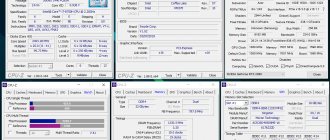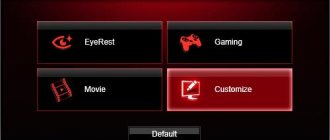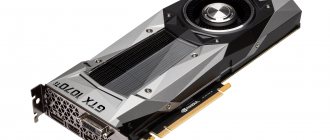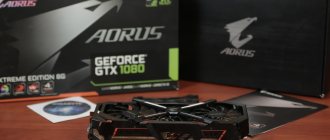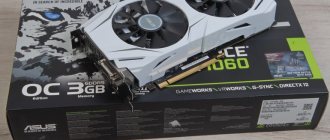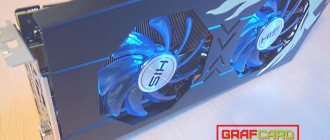Graphics card specifications
The characteristics of the HD 4000 are quite modest even at the time the graphics chip was released; at the moment they look truly ridiculous.
The device can provide 16 unified processors. The highest clock frequency of the graphics chip can reach 1350MHz. The actual frequency depends on many factors, including the model of the processor into which the chip will be integrated, as well as the type of device. Laptops and other unproductive devices are almost always cut down in terms of CPU and video core frequencies.
The amount of memory available for the needs of the video adapter will depend on two factors: BIOS settings and the amount of RAM installed on the computer. If you are seriously going to use this particular graphics chip, you should fork out for good RAM sticks with higher frequencies.
The memory bus width reaches 128 bits (in dual-channel RAM mode, single-channel mode will allow you to get only 64 bits).
Intel HD 4000 has support for DirectX 11.1, OpenGL 4.1 and Quick Sync. You can’t even dream of any DirectX 12, OpenGL 4.5, OpenCL and Vulcan with this video card, it doesn’t support them.
Benchmark comparison
GPU 1: Intel HD Graphics 630 GPU 2: NVIDIA GeForce GTX 560
| PassMark - G3D Mark | GPU 1 |
| GPU 2 |
| 2721 |
| GPU 2 |
| 365 |
| GPU 2 |
| 8037 |
| GPU 2 |
| 25.82 |
| GPU 2 |
| 623.187 |
| GPU 2 |
| 2.201 |
| GPU 2 |
| 30.402 |
| GPU 2 |
| 62.233 |
| GPU 2 |
| 3754 |
| GPU 2 |
| 3687 |
| GPU 2 |
| 3358 |
| GPU 2 |
| 3754 |
| GPU 2 |
| 3687 |
| GPU 2 |
| 3358 |
| Name | Intel HD Graphics 630 | NVIDIA GeForce GTX 560 |
| PassMark - G3D Mark | 1176 | 2721 |
| PassMark - G2D Mark | 266 | 365 |
| Geekbench - OpenCL | 4896 | 8037 |
| CompuBench 1.5 Desktop - Face Detection (mPixels/s) | 28.95 | 25.82 |
| CompuBench 1.5 Desktop - Ocean Surface Simulation (Frames/s) | 326.25 | 623.187 |
| CompuBench 1.5 Desktop - T-Rex (Frames/s) | 1.934 | 2.201 |
| CompuBench 1.5 Desktop - Video Composition (Frames/s) | 20.795 | 30.402 |
| CompuBench 1.5 Desktop - Bitcoin Mining (mHash/s) | 33.396 | 62.233 |
| GFXBench 4.0 - Car Chase Offscreen (Frames) | 2041 | 3754 |
| GFXBench 4.0 - Manhattan (Frames) | 1945 | 3687 |
| GFXBench 4.0 - T-Rex (Frames) | 3344 | 3358 |
| GFXBench 4.0 - Car Chase Offscreen (Fps) | 2041 | 3754 |
| GFXBench 4.0 - Manhattan (Fps) | 1945 | 3687 |
| GFXBench 4.0 - T-Rex (Fps) | 3344 | 3358 |
| 3DMark Fire Strike - Graphics Score | 391 | 0 |
What tasks is the Intel HD 4000 suitable for?
First of all, office work in undemanding applications or ensuring the browser works. Almost any more or less current video card can cope with such tasks, and the Intel HD 4000 is no exception.
It’s suitable for watching movies, but it’s better not to use it for high resolutions. It will perfectly play movies and other videos in HD or FullHD resolution, but it won’t cope with the increasingly popular UltraHD (4K), it simply won’t have enough performance. If you don't have a monitor or TV that supports UltraHD, then the Intel HD 4000 is quite enough for watching movies. Owners of modern 4K panels are better off looking at a graphics card that has better performance than the HD 4000.
With games, the HD 4000 is even worse. Even at the time of release (in 2011), the video card could not run absolutely all current games with sufficient performance.
The Intel HD 4000 will handle games from 2010 or earlier very well, although not perfectly. Some projects fundamentally refuse to run normally on older integrated video cards, which can result in some rather strange problems.
The Intel HD 4000 is practically unsuitable for working in specific software (video editors, 3D modeling, rendering). The video core only supports Intel Quick Sync technology, which cannot be called particularly widespread. The more common OpenCL is not supported on this graphics chip. Even if the desired application allows you to use Quick Sync, the Intel HD 4000 does not have enough performance to run such software.
Gaming performance
With games it's a little more complicated. Any old games will run at maximum or close to maximum graphics settings, which is not bad for a video card built into the processor.
With modern projects everything is a little worse. Formally, the HD 630 is capable of running any game, no matter how demanding it may be. But in reality, everything will depend on the performance of the chip, and which games will run at an acceptable frame rate depends on the requirements and technology of the game itself.
Some Civilization 6 will work very well, because it is not too demanding on video card resources, and the turn-based gameplay will allow you to have fun even with insufficient performance. The same Battlefield 1 will be able to run, but you will get a natural slide show, which is simply not acceptable for a multiplayer game.
Drivers
Installing a driver on Windows is quite simple; all you need to do is download it and run the installation package; nothing more is required from you. The update can be done in two ways. The first is to use Intel settings or automatic software updates. The second is to manually download the new driver version and reinstall it.
In operating systems of the Linux family, everything is quite sad. The proprietary driver (developed by Intel) is available only on newer models of Intel HD video cards; this video adapter is not supported. Therefore, under Linux, you can only use a free driver, which is inferior in almost all aspects to the driver on Windows. The proprietary driver is updated automatically along with the operating system, but if you want to install a version that is not available on your distribution, you will need to update the Mesa 3D kernel and libraries.
⇡#Far Cry 2
Look: in a popular four-year-old shooter, the performance of modern integrated graphics developed by Intel is already quite sufficient for a comfortable game. True, so far with low image quality. Nevertheless, the diagram clearly shows how rapidly the speed of integrated Intel solutions grows with the change in processor generations. If we assume that with the advent of Haswell processors this pace will be maintained, then we can expect that next year discrete video cards of the Radeon HD 6570 level will become unnecessary.
⇡#Performance when working with video
There are two concepts involved in working with video in the case of HD Graphics graphics cores. On the one hand, this is the playback (decoding) of high-resolution video content, and on the other, its transcoding (that is, decoding followed by encoding) using Quick Sync technology.
As for decoding, the characteristics of the new generation of graphics cores are no different from what came before. HD Graphics 4000/2500 supports full hardware video decoding in AVC/H.264, VC-1 and MPEG-2 formats via the DXVA (DirectX Video Acceleration) interface. This means that when playing video using DXVA-compatible software players, the load on the processor's computing resources and its power consumption remain minimal, and the work of decoding the content is performed by a specialized unit that is part of the graphics core.
However, exactly the same thing was promised in Sandy Bridge processors, but in practice in a number of cases (when using certain players and when playing certain formats) we encountered unpleasant artifacts. It is clear that this was not due to any hardware flaws in the decoder built into the graphics core, but rather to software flaws, but this does not make it any easier for the end user. By now, it seems that all childhood illnesses have already gone away, and modern versions of players cope with video playback in systems with new generation HD Graphics without any complaints about image quality. At least, on our test set of videos of various formats, we were not able to notice any image defects either in the freely distributed Media Player Classic Home Cinema 1.6.2.4902 or VLC media player 2.0.1, or in the commercial Cyberlink PowerDVD 12 build 1618 .
When playing video content, the processor load is also expectedly low, because the main work falls not on the computing cores, but on the video engine located in the depths of the graphics core. For example, playing Full HD video with subtitles turned on loads the Core i5-3550 with the HD Graphics 2500 accelerator, on which we tested it, by no more than 10%. Moreover, the processor remains in an energy-saving state, that is, it operates at a frequency reduced to 1.6 GHz.
It must be said that the performance of the hardware decoder is easily enough for simultaneous playback of several Full HD video streams at once, and for playback of “heavy” 1080p videos encoded with a bitrate of about 100 Mbit/s. However, it is still possible to “bring the decoder to its knees”. For example, when playing an H.264 video encoded at a resolution of 3840x2160 with a bitrate of about 275 Mbps, we were able to observe frame drops and stuttering, despite the fact that Intel promises support for hardware video decoding in large formats. However, the specified QFHD resolution is used very, very rarely at the moment.
We also checked the operation of the second version of Quick Sync technology, implemented in Ivy Bridge processors. Since Intel promises increased transcoding speeds with the new graphics cores, our primary focus was on performance testing. During our hands-on testing, we measured the transcoding time of one 40-minute episode of a popular TV series encoded in 1080p H.264 at 10 Mbps for viewing on an Apple iPad2 (H.264, 1280x720, 4Mbps). For tests, we used two utilities that support Quick Sync technology: Arcsoft Media Converter 7.5.15.108 and Cyberlink Media Espresso 6.5.2830.
The increase in transcoding speed is impossible not to notice. The Ivy Bridge processor, equipped with the HD Graphics 4000 graphics core, copes with the test task almost 75 percent faster than the previous generation processor with the HD Graphics 3000 core. However, the stunning increase in performance seems to have occurred only with the older version of the Intel graphics core. At least, when comparing the transcoding speed of the HD Graphics 2500 and HD Graphics 2000 graphics cores, no such striking gap is observed. Quick Sync in the younger version of Ivy Bridge graphics works significantly slower than in the older one, as a result of which processors with HD Graphics 2500 and HD Graphics 2000 produce performance that differs by about 10 percent when transcoding video. However, there is no need to grieve over this. Even the slowest version of Quick Sync is so fast that it leaves far behind not only software decoding, but also all the Radeon HD options that speed up video encoding with its programmable shaders.
Separately, I would like to touch upon the issue of video transcoding quality. Previously, there was an opinion that Quick Sync technology gives significantly worse results than accurate software transcoding. Intel did not deny this fact, emphasizing that Quick Sync is a tool for quickly obtaining results, and not at all for professional mastering. However, in the new version of the technology, according to the developers, the quality has been improved due to changes in the media sampler. Was it possible to achieve the quality level of software decoding? Let's look at the screenshots that show the result of transcoding the original Full HD video for viewing on the Apple iPad 2.
Software transcoding, x264 codec:
Transcoding using Quick Sync technology, HD Graphics 3000:
Transcoding using Quick Sync 2.0 technology, HD Graphics 4000:
To be honest, no fundamental qualitative improvements are visible. Moreover, it seems that the first version of Quick Sync gives even better results - the image is less blurry and fine details are visible more clearly. On the other hand, the excessive clarity of the picture on HD Graphics 3000 adds noise, which is also an undesirable effect. One way or another, to achieve the ideal, we are again forced to advise turning to software transcoding, which can offer higher-quality conversion of video content, at least due to more flexible settings. However, if you plan to play the video on any mobile device with a small screen, using Quick Sync of both the first and second versions is quite reasonable.
